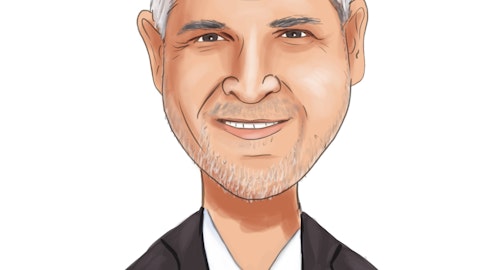Mark Marcon: Great. And then, can you talk a little bit about Flex gross margins and just how the discussions are going with regards to, you know, pay bill ratio? And what are you seeing in terms of the pay ratios? Because, you mentioned year-over-year roughly 2% growth, you know, which is slightly below inflation. How are the pay rates going? What is the competition like for the consultants? Do you have more flexibility with regards to managing those? How should we think about the gross margins on the Flex side going forward?
David Kelly: Yes. So, Mark, good. This is Dave again. I think I’d start out by saying in a very positive way, same story, different day, right. So, as you pointed out, bill rates continue to hold up well, still north of $90, as you point out, up a couple of percent. We think that continues to be reflective of a low supply, high demand for highly skilled talent, which is obviously reflective of our bill rate. I made a specific comment, and this has been a consistent comment over the course of the last many quarters, there clearly is an upward bias over the — in the longer term for increased bill rates given the dynamics in the marketplace and the need for this talent. As it relates to margins and spreads, the spread between bill and pay rates continues to be very consistent.
In this slower environment, you know, we did actually see, you know, a slight decline, but as I’d mentioned, that’s Healthcare cost related predominantly. So, that spread between bill rates and pay rates continues to be very stable. And the last comment I would make is kind of a reiteration of my prepared remarks is, you know, in the longer term, not atypical in a slow environment as things improve, although sometimes you might see lags, we would typically see some expansion in the longer term. So again, the dynamics are playing out as they have historically here.
Mark. Marcon: Appreciate the comments. Thank you.
Operator: Your next question comes from the line of Trevor Romeo from William Blair. Please go ahead.
Trevor Romeo: Hi. Good afternoon. Thanks so much for taking the questions. I will also congratulate Dave and Jeff on their new roles. First, you know, I was just wondering if you might have any insights from client conversations on how IT budgets are trending as we kind of move into the year-end budget cycle and what that might mean for IT project spending for your clients next year?
Joe Liberatore: Yes, Trevor, this is Joe Liberatore. I’d say most of our clients are still in the early terms of locking down 2024 budgets. However, as a whole, what we’re really hearing about is kind of flat to slightly increasing budgets over 2023, with an emphasis on projects that are focused to gain efficiencies both internally and externally. Needless to say, there is industries and client-specific drivers which we believe play to our favor with the quality, the diversity of our overall portfolio. But we’re seeing budget discussions being allocated a little bit differently than prior years. There seems to be a focus on stretching the dollar to get more out of it. I would say on our end, the good news is, that’s really opening up more opportunities for us as clients are no longer exclusively looking at traditional consulting firms due to, you know, the cost differential between with those firms who engage versus a Kforce or firms like Kforce.
So, we believe that that provides a lot of opportunity for us with a more efficient options to staffing and solutions within those clients. Does that give you a feel for what you’re looking for?
Trevor Romeo: Yes. Thanks, Joe. That was helpful. And then, I guess, you know, to the team’s credit, I think Kforce’s revenue on the Tech side continues to hold up better than a lot of companies in the peer set. Just wondering from your perspective, are you seeing any notable changes in, you know, market share or competitive behavior across the market? Do you see further opportunity to take market share in this type of environment?
Joe Liberatore: Yes. I think, you know, we’ve seen some of our competitors are performing well in this, you know, challenging environment as much as we are. And what I would say is probably, you know, we like to see our competitors do well because that’s an indication of the overall opportunities in the market. I would say probably not just us, but probably them as well. I think probably more of the market there is coming from the more localized and regional operators than those that have very expanded platform, and, you know, because we continue to see our opportunity pipeline build. As we were moving through Q3 and into the early part of Q4, our existing projects and our strongest pipelines, they’ve really been in and around application development, around digital transformation initiatives, which often focus on those customer and internal experiences, realizing much of that work also touches our cloud practices which we really like and we’re also seeing a lot of things happening from a data standpoint, which also often have cloud requirements within there.
Existing projects and pipeline opportunities in the data side are really more traditional. Although, you know, we are starting to see some of the front-end aspects as customers are experimenting with and exploring AI and really setting themselves up to take care of that. So, I think with all that said, we believe we’re really focused on those areas where demand is there. Application development, cloud, data, and digital, all continue to be robust areas and really position us well near-term and long-term. So I would say, part of the driver I believe is, we’ve honed our focus so much over the years and we’re focused in those areas where there is so much mission-critical stuff that’s taking place, I’m not inside competitors, I don’t know how focused they’ve become.


